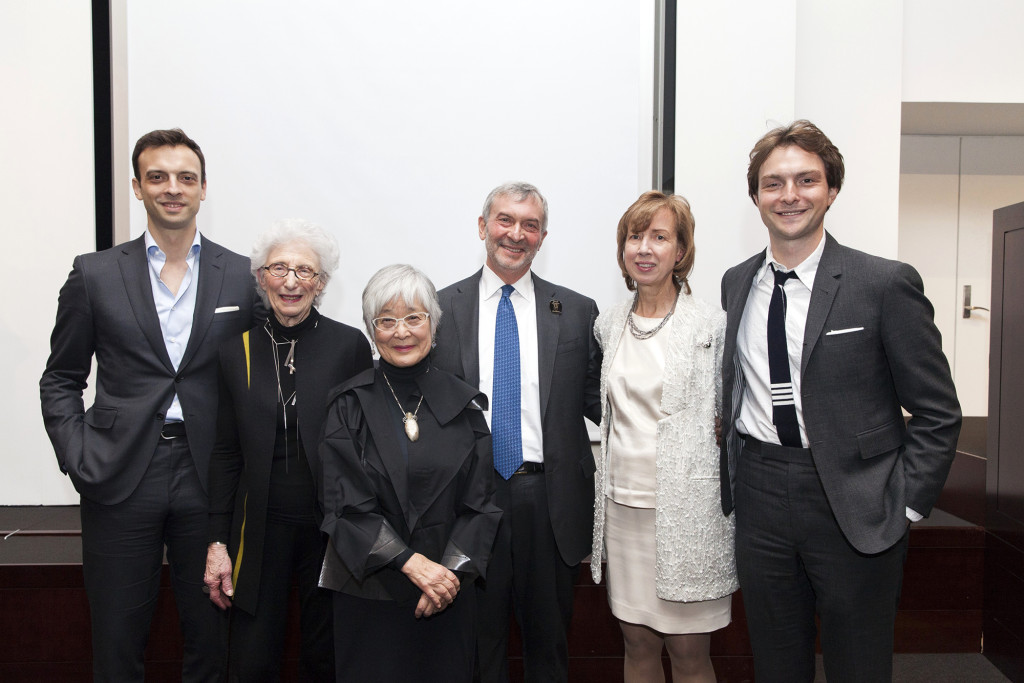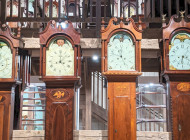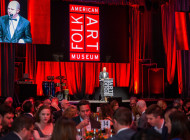
The recipients of the 2020 Eric M Wunsch Award for Excellence in the American Arts, presented by the Wunsch Americana Foundation, were Laura Beach, Lita Solis-Cohen and Mira Nakashima. From left, Eric Wunsch, Lita Solis-Cohen, Mira Nakashima, Peter Wunsch, Laura Beach and Noah Wunsch. Photo courtesy Christie’s.
By Greg Smith
NEW YORK CITY — More than 400 people filtered into a Christie’s sales room on January 22 as The Wunsch Americana Foundation, led by Peter Wunsch with sons Eric and Noah, honored the 2020 recipients of the Eric M Wunsch Award for Excellence in the American Arts, given this year to Laura Beach, Lita Solis-Cohen and Mira Nakashima.
Eric Wunsch welcomed the crowd to the 8th edition of this ceremony, referencing the intrinsic qualities that the Wunsch Americana Foundation looks for in the recipients of its award, while describing the attributes and initiatives that will guide the direction of the foundation moving forward.
“I’d like to think in some small way this annual coming-together of the American design community approximates … an occasion to share ideas, new initiatives and opportunities, and to celebrate the accomplishments of our friends and colleagues,” Eric Wunsch said. “Speaking with one of our honorees last week, giving an overview of what the foundation is working on and moving ahead on in 2020, we talked about the need for innovation, energy and disruption in American antiquities, and vehicles for communicating with potential future lovers in American design. This conversation reminded me that we frequently talk about innovation in the abstract, as an imperative in and of itself, but with ambiguous goals and metrics for success. Innovating with intent is an objective that we as an organization will prioritize in the coming years, evaluating high-impact initiatives and platforms for American design. Evolving the narrative in traditions of American design has been a guiding principal for tonight’s honorees.”
Indeed, two of the award recipients were journalists, and both were directly responsible for shaping the narrative in the antiques field in past decades. Both Laura Beach and Lita Solis-Cohen have reported on landmark sales, research initiatives presented through exhibitions and notable publications, antiques shows and discoveries.
Upon accepting her award, Laura Beach, the editor-at-large of Antiques and The Arts Weekly, said, “I’ve always been interested in the people that made this business what it is, this field what it is. Their passion for objects and their determination to document objects in a scholarly way. That, to me, is what animates objects and the industry — it really is about the people.”
In her three decades of reporting, Beach has written for The Magazine Antiques and contributed to Antiques & Fine Art, The New York Times, Architectural Digest, Art + Auction and Connoisseurs Quarterly, and authored a book on artist Stephen Huneck.
Lita Solis-Cohen has been writing about antiques since 1973. The 89-year-old senior editor at Maine Antiques Digest (MAD) worked at the Philadelphia Museum of Art in the education department for 20 years before she picked up her pen, coming into the business of antiques market reporting as the flint snapped down and the prices boomed. Solis-Cohen is known for her candidness and determination to shine a light on the Americana market. Editor and publisher of MAD S Clayton Pennington called her, “in a word, indefatigable.”
In true-to-form fashion, Solis-Cohen accepted the award by embarking on her testimony of the market, using single owner sales, landmark results and discoveries to illustrate the highlights of her career. In addition to covering these important events, Solis-Cohen said, “The more I experience, the more I learn, and the more I can appreciate the best. That’s why I like to cover regional sales and small shows in gymnasiums, ice rinks, fairgrounds, firehouses, church halls, hotel ball rooms, tents, convention centers and armories, I go to all of them. And January in New York is my favorite week of the year, its where the cream rises. It’s great fun, and a great way to stay young.”
Mira Nakashima accepted the award for her efforts in continuing the legacy of the Nakashima Woodworkers studio following her father George Nakashima’s death in 1990. Mira spoke about the rise of the international market for her contemporary studio’s offerings as well as those made by her father earlier on. She credited the secondary market for this — in establishing the Nakashima style among the highest levels in the American design canon of the Twentieth Century.
In conclusion, Peter Wunsch reiterated his foundation’s directive in building a bridge between historic American design and the very best from Twentieth Century and contemporary makers. The foundation plans to release word of its upcoming initiatives in the near future.




